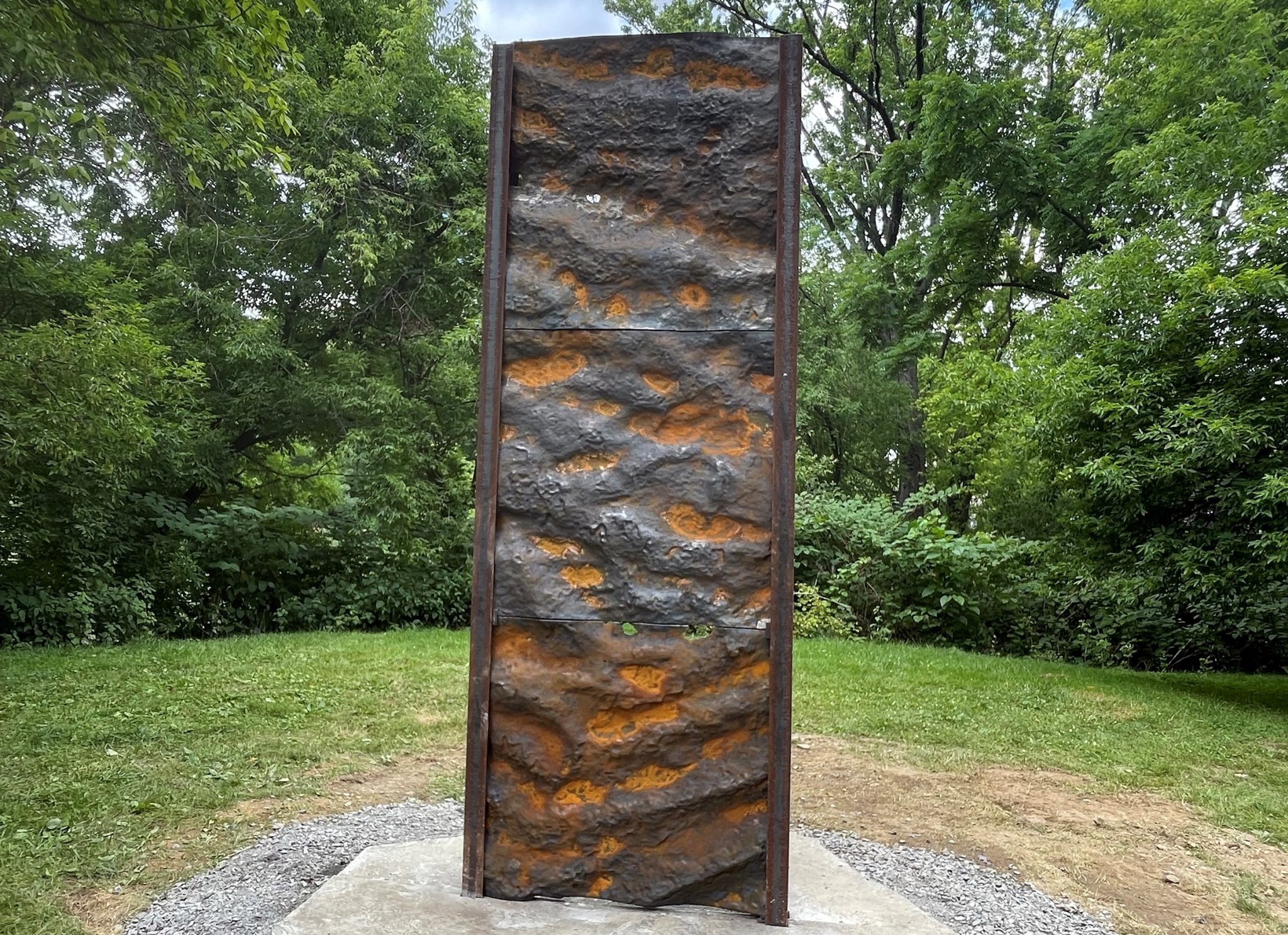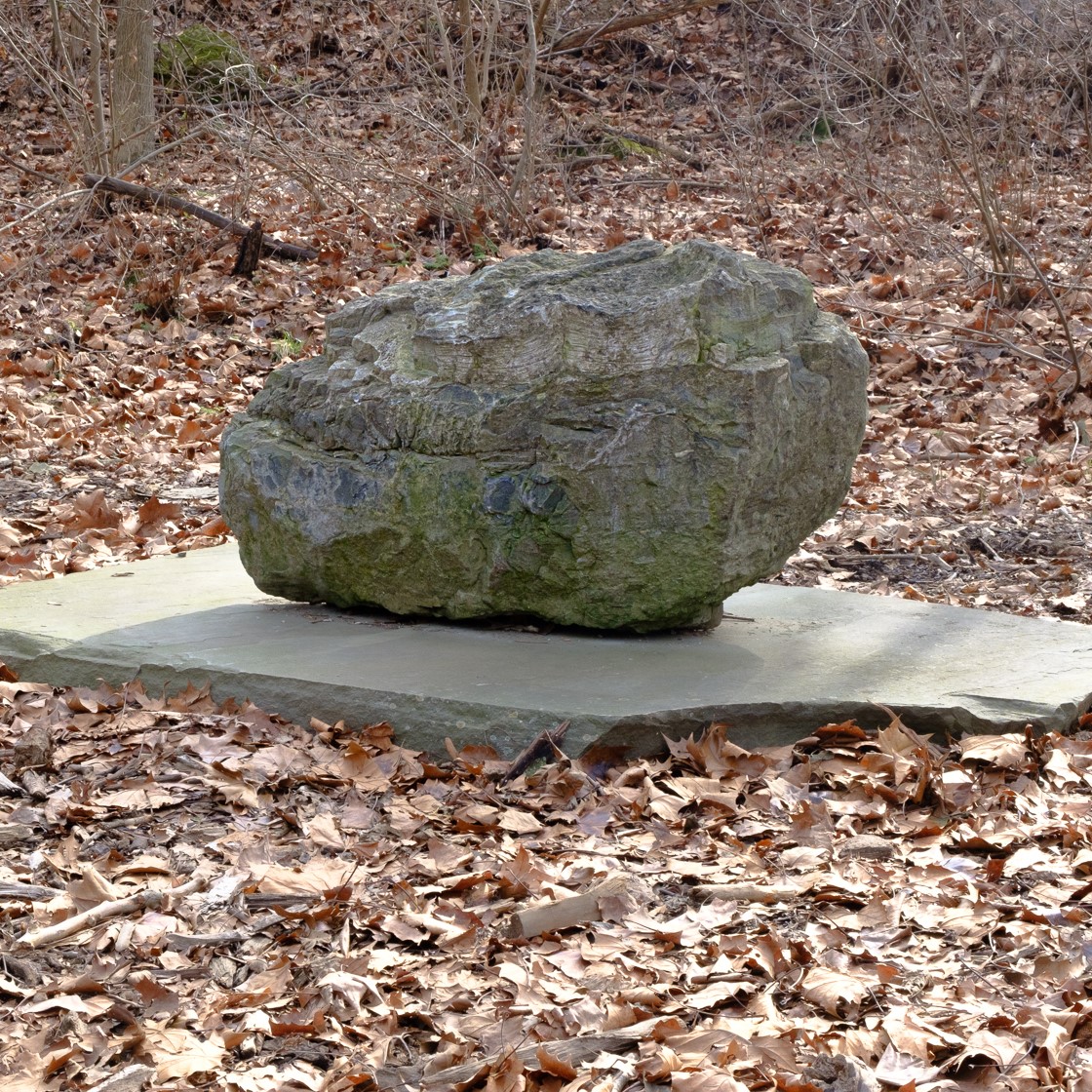Rocks, cast iron, and steel, 2022

Debuting in July 2022, Upriver was directed, developed, researched, and constructed by Heidi Wiren Bartlett in collaboration with local artists, scholars, geologists, musicians, and engineers. Each element was constructed to reflect the potent history of the Lehigh Valley and the myths of “The Place at the Forks.” Director of photography is Margaret Champagne. (Learn about the related performance event pictured above.)
 Gneiss Stone from Hexenkopf Complex (above)
Gneiss Stone from Hexenkopf Complex (above)
Rock, 13″ x 20.5″ x 8.5″
Much of the metamorphic rock that forms the foundational “basement” of Easton is more than one billion years old. Formed under great pressure and heat deep in the earth during an ancient orogeny (mountain-building event), it is no longer the rock it once was. The rock, now a gneiss, is exposed at the surface after the mountains eroded away.
 Hardyston Sandstone
Hardyston Sandstone
Rock, 11″ x 39″ x 23″
Easton’s first sedimentary rock layer is the Hardyston sandstone. Its presence harkens back to a time of sea level rise in the Cambrian Period more than 500 million years ago. As sea level rises, beach sand conditions encroach further onto the continent. It is a process that has repeated itself numerous times throughout Earth’s history and likely will again.
 Mudcracks, Allentown Formation
Mudcracks, Allentown Formation
Cast iron and steel, 42″ x 52″ x 3″
The nature of Nature is change. Though the limey muds of the 500-million-year-old Allentown Formation are reflective of ancient shallow seas, the structures represented here are drying-out mud cracks. Whether because of a quick sea level fall or tropical Easton briefly uplifted, these structures formed under the Cambrian equatorial sun.
 Ripple Marks, Allentown Formation
Ripple Marks, Allentown Formation
Cast iron and steel, 10’ x 44″ x 3″
Even ocean waves, as fleeting as they are, can leave their record in stone. Oscillations of water in a shallow sea would leave rippled ridges on the seafloor mud. The local sedimentary bedrock layer is from the Cambrian-age Allentown Formation. This 500 million-year-old deposit was laid down beneath the heaving seas of an ancient tropical ocean.
 Stromatolite, Allentown Formation
Stromatolite, Allentown Formation
Rock, 29” x 45” x 22”
Easton’s paleogeographic position was tropical around 500 million years ago. Rocks such as this piece of Allentown Formation reflect a time when limey mud was laid down in shallow seas. This stone is evidence of a time when calm azure waters contained stromatolite laminations accumulated with the help of photosynthetic microbes. This specimen also records a tumultuous storm event with torn-up, angular fragments — a fossilized hurricane.
Bartlett is a filmmaker, sculptor, and performance artist from the Great Plains. Her work is concerned with the portrayal, oppression, and subversive existence of women in America today. She sees her body as an object of power and vulnerability, and she sees nature and its processes in the same way. Together these inspire a practice that illuminates the overlooked and forgotten. Whether creating laborious actions or objects, she blurs the line between public and private, deconstructing notions of gender, race, and corporeality. She holds an MA and MFA in intermedia from the University of Iowa. A Pittsburgh resident, she is an artist and designer at Carnegie Mellon University and co-founder of Propelled Animals, a transdisciplinary arts and social justice collective.
In 2021, Bartlett’s work was featured in Resonance: The Journal of Sound and Culture. She was a Max Kade Fellow at Lafayette College, an artist-in-residence at the Kelly Strayhorn Theater in Pittsburgh, and a National Performance Network Artist Engagement Fund and Storytelling Grant awardee. She was nominated for the United States Artists Fellowship and selected as a roundtable scholar for the spring 2020 What Can Museums Become? symposium hosted by the Stanley Museum of Art at the University of Iowa.
Her studio is housed at the Brew House Association in Pittsburgh, and she is an artist-in-residence at High Concepts Labs in Chicago.
“The deep time recorded in the Pennsylvanian landscape is unlike anything I’ve known, including the geologic time that birthed the American Industrial Revolution. There’s magic in these mountains, and they have much to tell,” she says.
Learn more about Heidi Wiren Bartlett.
Upriver was sponsored by the Lehigh Valley Engaged Humanities Consortium (LVEHC), with generous support provided by a grant to Lafayette College from the Andrew W. Mellon Foundation.
Special thanks to the following Upriver collaborators (all in Pennsylvania):
Horses Unplugged, Bethlehem
Bluestone Gardens, Raubsville
Jim Caffrey Studios, Easton
Easton Public Works Department, Easton
Quality Machining and Fabrication, Easton
Rivers of Steel, Pittsburgh
Visionary Effects, Pittsburgh


